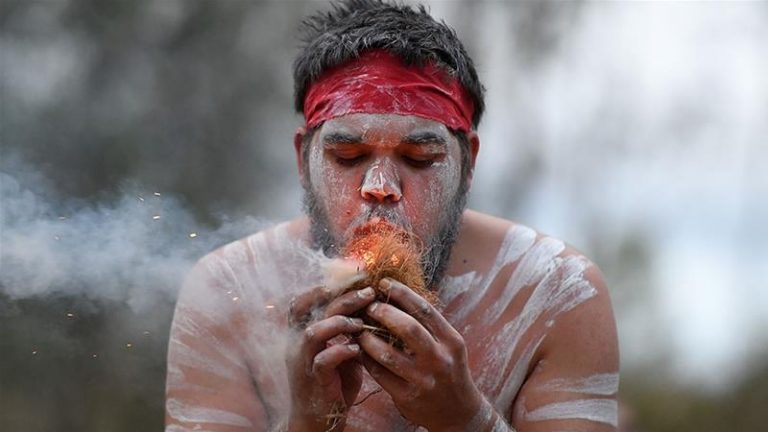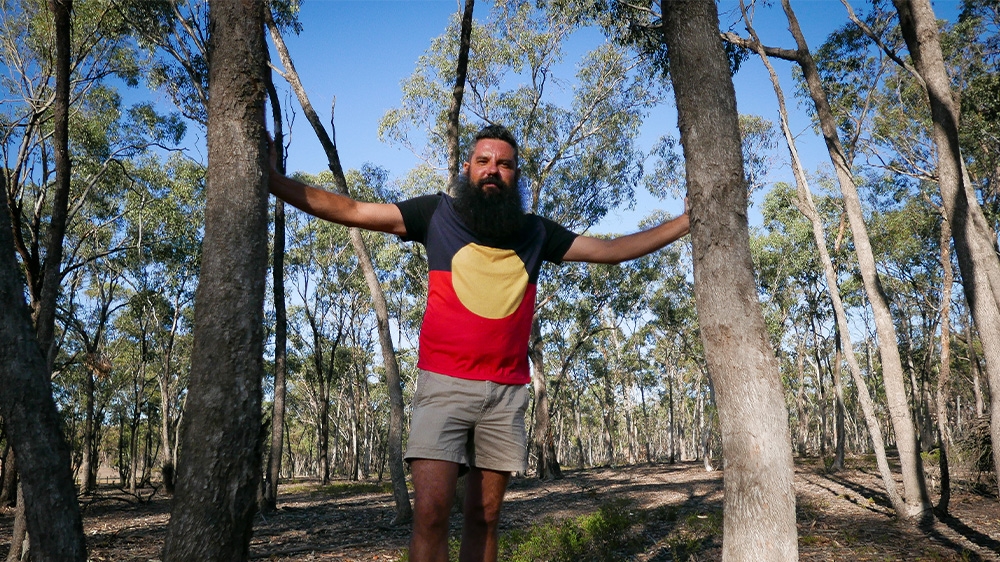
Aboriginal park ranger Trent Nelson walks through the bush, demonstrating traditional fire techniques.
He mimics the lighting of small spot fires on certain shrubs – fires his ancestors have lit for thousands of years before him.
“What happens, is when the fire goes through, a lot of these plants don’t get impacted,” he explained.
“The fire only gets to probably about [a foot] high as it goes through, so these are protected and they can grow. It also protects the trees in the canopy.”
In the Dja Dja Wurrung traditional lands in the northern part of Australia’s Victoria state, this section of the bush is known as Djandak Wi, meaning “fire country”.
When Aboriginal people use the word “country”, they refer to the distinct region they come from, with pre-colonial Australia akin to an indigenous version of Europe.
And while catastrophic bushfires rage across much of Australia, the “country” of Djandak Wi is eerily quiet and peaceful.

Reading the land
The soft sound of insects scurrying in the undergrowth is interrupted only by the wind in the trees overhead and the distinct call of a kookaburra.
The gentle fragrance of eucalyptus hangs in the air, a stark contrast to the pungent haze of smoke that engulfs much of southeastern Australia.
This is the bush that Australians – and millions of tourists alike – have come to know and love.
Yet this is also the bush that indigenous people maintained for thousands of years prior to colonisation, in particular, through the use of fire.
Nelson describes how Aboriginal people would move through the bush, systematically setting undergrowth alight, in order to promote the growth of new plants, rid the bush of flammable materials such as bark and leaf litter and attract animals to hunt.
In fact, the practice of lighting fires was such a constant feature of daily life for indigenous people, that the first European colonisers noticed.
Reading the land
But cultural burning is not only about avoiding bushfires.
As Nelson explains, fires were traditionally lit “for cultural purposes – for hunting and regeneration of food and fibre in the landscape.”
“Food for us to survive is not just the animals that we hunted – kangaroos, emus, fish – but also the starchy fibrous tubers that grow in the ground. They actually need burning on a regular basis to provide that propagation of the seed and seed banks.”

‘Fire is a tool’
The use of fire also has particular cultural protocols, and as Nelson repeatedly states, was not simply used as a way to mitigate catastrophic bushfires.
However, Nelson says that it is evident that Aboriginal fire management techniques do reduce fire risk, and that indigenous people should be acknowledged and involved if Australia is to tackle the fire threat it faces.
“Fire for us is a tool. We know that it was used in the landscape for thousands and thousands of generations. For us, fire is not to be afraid of.”
Bush as fuel
Barber also maintains that the use of cultural burning could contribute to a reduction of large-scale bushfires.
“It doesn’t matter where I go – I can go to any National Park and more often than not you find huge fuel loads in the bush. Tourists think it’s lovely, but all I see is rubbish. All I see is a ticking time bomb, knowing the amount of fuel sitting in that area of the national park. And sure enough, what we end up with are these wildfires.” (Aljazeera)





